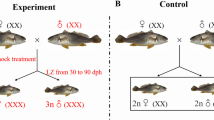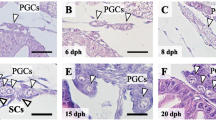Abstract
Sustainable fisheries and aquaculture production serve as means of achieving nutritional security and sources of employment for large number of people in the world. Fisheries play an important role in enhancing foreign earnings and solving malnutrition problems. However the state of global food fish insecurity due to continuous decline in capture fisheries needs serious attention. This is as a result of variability in climate, anthropogenic pressures, ecosystem degradation and increasing demand for fish and its products by increasing human population. Developments of biotechnology strategy such as genetic manipulations in fisheries management have been recently employed in developed economies to increase fish production. In this study, monosex larvae of African catfish (Clarias gariepinus) were produced using biotechnology techniques such as androgenesis and gynogenesis where catfish gametes were treated with UV irradiation at 30,000 μWcm−2 for 15 min. The fertilized treatment were then subjected to cold shock at 2 °C for 20 min. Eggs numbering 100 ± 10 each quadruplicates were induced for gynogenesis through activation with UV irradiated sperm and then cold shock. For androgenesis, irradiated eggs were fertilized with normal sperm followed by cold shock. For the control experiments, 100 ± 10 normal eggs in quadruplicates were fertilized with irradiated sperm to produce haploid embryos and normal milt to produce normal diploid embryos. Fertility, hatchability, and survival were monitored and recorded. Androgeneic, gynogeneic, haploid and normal diploid treatments gave fertility of 80 %, 72.5 %, 100 % and 100 % with standard error of mean (SEM) of 3.19 respectively. Hatchability (number of hatched embryos) was 5.5 %, 22 %, 15 % and 93 % with SEM of 9.05 for androgeneic, gynogeneic, haploid and normal diploid embryos. No survived larvae was recorded at yolk absorption for the haploid group while survival after 1 week for androgeneic, gynogeneic and normal diploid embryos gave 5 %, 13.25 % and 91 % (SEM = 9.65) respectively. Ploidy levels of the embryos were determined in 1-day old post-hatched embryos following modified protocol of Don J, Avtalion RR (Theor Appl Genet 72:186–192, 1986). The mean chromosome number (n) of 28 was obtained for haploid and 56 for normal diploid, androgeneic and gynogeneic larvae. However, sex specific DNA analysis is necessary to further confirm their sex determination, hence its potential applications in enhancing breeding strategies for research and commercial catfish aquaculture in Nigeria are discussed.
Access this chapter
Tax calculation will be finalised at checkout
Purchases are for personal use only
Similar content being viewed by others
References
Aluko PO (1998) Induction of meiotic gynogenesis with ultra-violet ray, in the African catfish, Clarias anguillaris. Nig J Biotechnol 1:76–81
Bongers ABJ, Ngueriga D, Eding EH, Richter CJJ (1995) Androgenesis in the catfish Clarias gariepinus. Aquat Living Resour 8:329–332
Bovendeur J, Eding EH, Henken AM (1987) Design and performance of water recirculation system for high-density culture of the African catfish, C. gariepinus (Burchell 1822). Aquaculture 63:329–355
Bromage NR, Roberts RJ (1995) Broodstock management and egg and larval quality. Iowa State University Press, A Blackwell Science Companion. 2121 S. State Avenue, Ames, Iowa, pp 6–24, 76–93
Cherfas NB (1981) Gynogenesis in fishes. In: Kirpichnikov VS (ed) Genetic bases of fish selection. Springer, Berlin, pp 255–273
Chourrout D (1982) Gynogenesis caused by ultraviolet irradiation of salmonid sperm. J Exp Zool 223:175–181
da Silva FSD, Moreira RG, Orozco-Zapata CR, Hilsdorf AWS (2007) Triploidy induction by cold shock in the South American catfish, Rhamdia quelen (Siluriformes) (Quoy & Gaimard, 1824). Aquaculture 272:S110–S114
Dawley RM (1989) An introduction to unisexual vertebrates. In: Evolution and ecology of unisexual vertebrates. University of the State of New York, Albany, New York, USA, pp 1–18
de Graaf GJ, Janssen J (1996) Handbook on the artificial reproduction and pond rearing of the African catfish Clarias gariepinus in sub-Saharan Africa, FAO fisheries technical paper 362. Nefisco Foundation, Rome/Amsterdam, pp 13–50
Diter A, Quillet E, Chourrout D (1993) Suppression of first egg mitosis induced by heat shocks in the rainbow trout. J Fish Biol 42:777–786
Don J, Avtalion RR (1986) The induction of triploidy in Oreochromis aureus by heat shock. Theor Appl Genet 72:186–192
Dunham RA (2004) Aquaculture and fisheries biotechnology: genetic approaches. CABI Publishing, Wallingford, p 385
Fafioye OO, Adeogun OA (2005) Homoplastic hypophysation of African Catfish, Clarias gariepinus. Niger J Anim Prod 32(1):153–157
FAO (2001) FAO Corporate Document Repository. What is the code of responsible Fisheries? Fisheries and Aquaculture Department. Food and Agriculture Organization of the United Nations’ Code of Conduct for Responsible Fisheries
FAO (2009) The state of world fisheries and aquaculture, 2008. FAO Fisheries and Aquaculture Department, Food and Agricultural Organization of the United Nations, Rome, Italy
Galbusera P, Volckaert FAM, Ollevier F (2000) Gynogenesis in the African catfish Clarias gariepinus (Burchell, 1822) III. Induction of endomitosis and the presence of residual genetic variation. Aquaculture 185:25–42
Guyomard R (1984) High levels of residual heterozygosity in gynogenetic rainbow trout, Salmo gairdneri, Richardson. Theor Appl Genet 67:307–316
Han H, Mannen H, Tsujimura A, Taniguchi N (1992) Application of DNA fingerprinting to confirmation of clone in ayu. Nippon Suisan Gakkaishi 58:2027–2031
Hecht T, Oellermann L, Verheust L (1996) Perspectives on clariid catfish culture in Africa. Aquat Living Resour 9:197–602
Hussain MG, Penman DJ, Mcandrew BJ, Johnstone R (1993) Suppression of first cleavage in the Nile tilapia, Oreochromis niloticus L. – A comparison of the relative effectiveness of pressure and heat shocks. Aquaculture 111:263–270
Ihssen PE, McKay LR, McMillan I, Phillips RB (1990) Ploidy manipulations and gynogenesis in fishes: cytogenetic and fisheries applications. Trans Am Fish Soc 119:698–717
Komen J, Bongers ABJ, Richter CJJ, Van Muiswinkel WB, Huisman EA (1991) Gynogenesis in common carp (Cyprinus carpio): II. The production of homozygous gynogenetic clones and F1 hybrids. Aquaculture 92:127–142
Naruse K, Ijiri K, Egami N (1985) The production of cloned fish in the medaka (Oryzias latipes). J Exp Zool 236:335–341
Olufeagba SO, Aluko PO, Omotosho JS, Oyewole SO, Raji A (1997) Early growth and survival of cold shocked Heterobranchus longifilis Valenciennes, 1840 (Pisces: Clariidae). In: Proceedings of the 10th annual conference of the biotechnology society of Nigeria. Biotechnology and Sustainable Development in Nigeria, pp 213–220
Omitogun OG, Aluko PO (2002) Application of molecular and chromosomal tools in Tilapiine and Clariid Species for genetic improvement and stock management. Niger J Genet 17:15–22
Pandian TJ, Koteeswaran R (1998) Ploidy induction and sex control in fish. Hydrobiologia 384(1–3):167–243
Pandian TJ, Varadaraj K (1990) Techniques to produce 100 % male Tilapia. ICLARM, Makati, Metro Manila, Philippines 13(3):3–5
Parson JE, Thorgaard GH (1985) Production of androgenetic rainbow trout. J Hered 76:177–181
Purdom CE (1969) Radiation-induced gynogenesis and androgenesis in fish. Heredity 24:431–444
Purdom CE (1976) Genetic techniques in flatfish culture. J Fish Res Board Can 33:1088–1093
Purdom CE (1983) Genetic engineering by the manipulation of chromosomes. Aquaculture 33:287–300
Quillet E, Garcia P, Guyomard R (1991) Analysis of the production of all homozygous lines of rainbow trout by gynogenesis. J Exp Zool 257:815–819
Scheerer PD, Thorgaard GH, Allendorf FW (1991) Genetic analysis of androgenetic rainbow trout. J Exp Zool 260:382–390
Skelton P (1993) A complete guide to the freshwater fishes of Southern Africa. Southern Book Publishers Ltd., Halfway House
Standish KA Jr (1986) Genetic manipulations: critical review of methods and performances, shellfish. EIFAC/FAO symposium on selection, hybridization and genetic engineering in aquaculture of fish and shellfish for consumption and stocking, Bordeaux, France, 27–30 May
Stanley JG, Sneed KE (1974) Artificial gynogenesis and its application in genetics and selective breeding of fishes. In: Blaxter JHS (ed) The early life history of fish. Springer, New York, pp 527–536
Streisinger G, Walker C, Dower N, Knauber D, Singer F (1981) Production of clones of homozygous diploid zebrafish (Brachydanio rerio). Nature 291:293–296
Tave D (1993) Growth of triploid and diploid bighead carp, Hypophthalmichthys nobilis. J Appl Aquac 2:13–25
Thorgaard GH (1983) Chromosome set manipulation and sex control in fish. In: Hoar WS, Randall DJ, Donaldson EM (eds) Fish physiology, vol 9B. Academic, New York, pp 405–434
Thorgaard GH, Allendorf FW, Knudsen KL (1983) Gene-centromere mapping in rainbow trout: high interference over long map distances. Genetics 103:771–783
Thorgaard GH (1986) Ploidy manipulation and performance. Aquaculture 57:57–74
UNPP (2008) Population Division of the Department of Economic and Social Affairs of the United Nations Secretariat, World Population Prospects: the 2006 revision and world urbanization prospects: the 2005 revision. http://www.un.org/esa/population/publications/WPP2006RevVol_III/WPP2006RevVol_III_final.pdf. Accessed 26 Mar 2008
Váradi L, Benkó I, Varga J, Horváth L (1999) Induction of diploid gynogenesis using interspecific sperm and production of tetraploids in African catfish, Clarias gariepinus Burchell (1822). Aquaculture 173:401–411
Volckaert FAM, Galbusera PHA, Hellemans BAS, Van Den Haute C, Vanstaen D, Ollevier F (1994) Gynogenesis in the African catfish (Clarias gariepinus): III. Induction of meiogynogenesis with thermal and pressure shocks. Aquaculture 128:221–233
Volckaert FA, Van Den Haute C, Galbusera PH, Ollevier F (1997) Gynogenesis in the African catfish (Clarias gariepinus) (Burchell, 1822). Optimising the induction of polar-body gynogenesis with combined pressure and temperature shocks. Aquac Res 28:329–334
Yamamoto E (1999) Studies on sex-manipulation and production of cloned populations in hirame, Paralichthys oliÍaceus (Temminck et Schlegel). Aquaculture 173:235–246
Author information
Authors and Affiliations
Corresponding author
Editor information
Editors and Affiliations
Rights and permissions
Copyright information
© 2014 Springer Science+Business Media Dordrecht
About this chapter
Cite this chapter
Olaniyi, W.A., Omitogun, O.G. (2014). Monosex Fish Production in Fisheries Management and Its Potentials for Catfish Aquaculture in Nigeria. In: Behnassi, M., Syomiti Muteng'e, M., Ramachandran, G., Shelat, K. (eds) Vulnerability of Agriculture, Water and Fisheries to Climate Change. Springer, Dordrecht. https://doi.org/10.1007/978-94-017-8962-2_19
Download citation
DOI: https://doi.org/10.1007/978-94-017-8962-2_19
Published:
Publisher Name: Springer, Dordrecht
Print ISBN: 978-94-017-8961-5
Online ISBN: 978-94-017-8962-2
eBook Packages: Earth and Environmental ScienceEarth and Environmental Science (R0)




